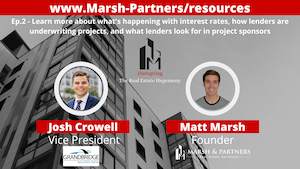The Effect of Rising Interest Rates & Why It May Be Good For Real Estate Investors
For the last decade, we’ve lived in a prolonged period of artificially low-interest rates. Real estate investors have enjoyed access to cheap capital and generally lax due diligence and underwriting standards from lenders as a result.
But the fallout from the Great Recession is still seared into the memories of many long-time real estate developers and investors - that hasn't slowed an unprecedented bull-run, sending real estate valuations to levels we've never seen before.
Rising interest rates are coming. Year over year inflation is the highest we’ve seen in over 40 years (longer if they calculated CPI the same today as they did decades ago). And to combat that runaway inflation, central banks have the power to manipulate interest rates to slow the economy and the rate of borrowing.
Keynesians and mainstream economists generally claim that higher interest rates are bad for the economy – buyers will no longer be able to afford homes, and the economy will come to a screeching halt.
But that’s not necessarily the case.
In this article, we’ll debunk some of the common myths about interest rates and real estate and explain precisely what real estate investors, business owners, and developers need to know going forward.
Interest rates and the overall economy
Typically, in a free market, lenders and financial institutions need to compete for borrowers' business - home buyers and investors, corporations, developers, and anyone else that may need a loan.
In the short term, that supply-demand relationship influences the interest rates consumers might see on a daily basis. For example, rates may rise as the demand for mortgages or loans increases, and vice versa.
However, the federal reserve and central planners can pull levers at the national level that significantly impact interest rates felt throughout the banking system and by individuals.
But what happens to the overall economy when interest rates begin to rise?
Very simply, we usually experience a widespread chilling effect across much of the economy.
Borrowed funds become more expensive, making it more difficult and costly for businesses to use debt as a catalyst for growth. This often hampers capital investment and may slow a business's growth ability.
And this, in turn, negatively impacts the stock market because a company's underlying stock price reflects its expected future cash flows. If projected growth decreases, so too does the stock price.
Bond prices move inversely with interest rates, so as interest rates rise, bond prices fall. In addition, the bond duration and time to maturity impact how sensitive a bond’s price may be to interest rate fluctuations, but principally, bond prices are negatively affected by rising interest rates.
But perhaps the most difficult to quantify result of rising interest rates is the psychology of investors. With the efficiency of information dissemination, expectations are frequently priced into the market before they’re formally released. If market expectations differ from the federal reserve's actions, the traditional market reactions may not apply.
Interest rates and home buying
On the surface, rising interest rates make home-buying more difficult. For example, a 100-basis point increase may add several hundred dollars to a $350K house mortgage payment.
It means that over the life of the mortgage, the cost of borrowed funds is more expensive, and thus the borrower pays more interest.
Conversely, on the seller side of the transaction, as rates rise, potential buyers may not be able to afford what they were able to in a low-rate environment.
The pool of potential buyers may shrink, and thus the demand for the property would decrease.
The rising rates may present a challenge for sellers who want to maximize the value of their home sales or capitalize on a large buyer pool.
Interest rates and real estate investment values
To understand how interest rates impact real estate values, we must first discuss how real estate values are derived.
As with any product or service, the price of real estate is usually determined by the market's overall supply and demand.
The prolonged historically low-rate environment we've experienced for the last decade-plus has resulted in a spike in demand for cash flow producing rental properties and thus an increase in real estate investment prices.
But the law of supply and demand only tells a fraction of the whole real estate investment valuation story.
There are several ways to value a piece of income-producing real estate – the comparable sales approach, replacement value, and the income approach. For the sake of this discussion, we will focus on the income approach valuation method.
The income approach is similar to a traditional discounted cash flow (DCF) analysis you might find in other fields of finance.
Rental income and positive property cash flows are forecasted for the property. Then a property’s operating expenses are netted, and any capital expenditures associated with the long-term upkeep of a property are also considered. Finally, the discount rate is used to discount all future cash flows to arrive at a real estate value in “today’s” dollars.
But that's where interest rates come into play.
Investors make capital allocation decisions based on relative risk and the opportunity cost of capital budgeting decisions.
The discount rate used to value a real estate investment equals an investor's total required return for a project. That total return requirement is influenced by the risk of the project and the return that could be experienced in another investment (risk-free rate + risk premium).
And since the risk-free rate is often substituted for the yield of a treasury bond with a similar maturity date to that of your project, as interest rates rise, so too does the discount rate investors use to value projects.
So transitively, as interest rates rise, the value of real estate investments will fall. Projected cash flows are discounted by a higher rate, and investors need to be compensated for that investment risk/opportunity cost by purchasing a property at a lower price.
Interest rates and real estate development
The real estate development process is complex and risky and involves labor and construction inputs throughout the project.
So, to fund the entire process, development financing becomes a critical hurdle that developers must navigate.
If we think about the capital stack for a development project, it’s usually comprised of some form of both debt and equity financing. The mixture of debt and equity used may depend on the developer's experience, the project's viability, and the relative cost of capital.
Traditionally debt is a cheaper means of financing, especially as interest rates have remained so historically low for years. And that availability of cheap debt has forced equity alternatives to compete on yield as well, offering developers several low-cost options to finance projects.
But historically, rising interest rates usually result in less development activity. Real estate developers and home builders tend to pull back due to the expected economic slowdown that typically accompanies higher interest rates.
Projects that would have been viable if financed primarily with inexpensive debt may no longer be practical through other means of financing.
But a reduced supply of development activity also translates to reduced demand for the construction labor and material inputs.
For the last couple of years, supply chain challenges and exorbitant construction costs have been a drain on the development and construction industries.
But a fervent demand for new homes and real estate investments on the back end hasn't significantly impacted development activity, even amidst rising prices.
But a slowdown in development activity because of rising interest rates will give supply chains and suppliers some breathing room to catch up with demand.
Construction prices will likely fall as a result, and the supply-demand equilibrium that has been thrown off by federal reserve manipulation may again be in the hands of the free market.
Why rising interest rates may not be a bad thing for real estate investors
We know that interest rates influence mortgage rates. We also know that interest rates affect an investor's capitalization and discount rates used to value a property.
As interest rates rise, the spigot controlling the flow of available capital will begin to compress. That's commonly seen as bad by real estate investors – underwriters tighten their standards, and it becomes more expensive to finance projects.
But that might actually be a good thing.
The rising tide of the last decade has lifted all ships – almost universally, real estate values have increased; investors, even inexperienced, have "won" if they invested in property.
It was true for investors with great business plans and mediocre business plans alike.
It was true for investors who underwrote properties conservatively but also valid for investors who were reckless and cavalier.
And the real estate investment community developed hubris, thinking that somehow, they had cracked the code and held the secrets to real estate investing success.
But that growth was primarily manufactured via historically cheap money.
The value appreciation and rent growth we’ve experienced masked many of the deficiencies of the investors themselves.
So, what will happen as monetary policy begins to tighten?
You’ll finally begin to see the more efficient allocation of resources into real estate.
Every part-time investor that has crowded the market for the last couple of years will no longer be able to compete.
Sound business plans will begin to trump lousy business plans.
Creative investors will be able to outcompete the masses because inexperienced investors will have a more challenging time raising money for deals.
And underwriting founded in reality will be more critical to success than the excessively rosy refinance assumptions and rent growth calculations we've grown accustomed to seeing in proformas the past few years.
Rising interest rates will present a 12–18-month window of opportunity for investors to capitalize on the market dislocation.
Individuals will begin to make more rational capital allocation decisions. And as the central planning manipulation eases, the free market will begin to reward investors that offer a competitive advantage.



